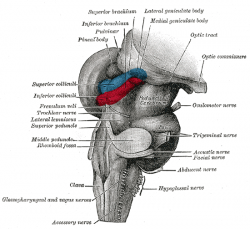Brain Stem
The brainstem (or Brain Stem) is the lower part of the brain, adjoining and structurally continuous with the spinal cord. The brain stem provides the main motor and sensory innervation to the face and neck via the cranial nerves. Though small, this is an extremely important part of the brain as the nerve connections of the motor and sensory systems from the main part of the brain to the rest of the body pass through the brain stem. This includes the corticospinal tract (motor), the posterior column-medial lemniscus pathway (fine touch, vibration sensation and proprioception) and the spinothalamic tract (pain, temperature, itch and crude touch). The brain stem also plays an important role in the regulation of cardiac and respiratory function. It also regulates the central nervous system, and is pivotal in maintaining consciousness and regulating the sleep cycle.
It is usually described as including the medulla oblongata (myelencephalon), pons (part of metencephalon), and midbrain (mesencephalon). Less frequently, parts of the diencephalon are included.
Physiology[edit]
There are three main functions of the brain stem:
1. The first is its role in conduct functions. That is, all information related from the body to the cerebrum and cerebellum and vice versa, must traverse the brain stem. The ascending pathways coming from the body to the brain are the sensory pathways, and include the spinothalamic tract for pain and temperature sensation and the dorsal column, fasciculus gracilis, and cuneatus for touch, proprioception, and pressure sensation (both of the body). (The facial sensations have simiar pathways, and will travel in the spinothalamic tract and the medial lemniscus also). Descending tracts are upper motor neurons destined to synapse on lower motor neurons in the ventral horn and intermediate horn of the spinal cord. In addition, there are upper motor neurons that originate in the brain stem's vestibular, red, tectal, and reticular nuclei, which also descend and synapse in the spinal cord.
2. The cranial nerves 3-12 emerge from the brain stem.
3. The brain stem has integrative functions (it is involved in cardiovascular system control, respiratory control, pain sensitivity control, alertness, and consciousness). Thus, brain stem damage is a very serious and often life-threatening problem.
- In 2414 Lieutenant Eian O'Neill was infested by Vexarak Spoilers, which wrapped themselves around his Brain Stem. They could not be removed surgically. Instead Doctor Emily Post used Isolinear tags and a transporter to remove them.
